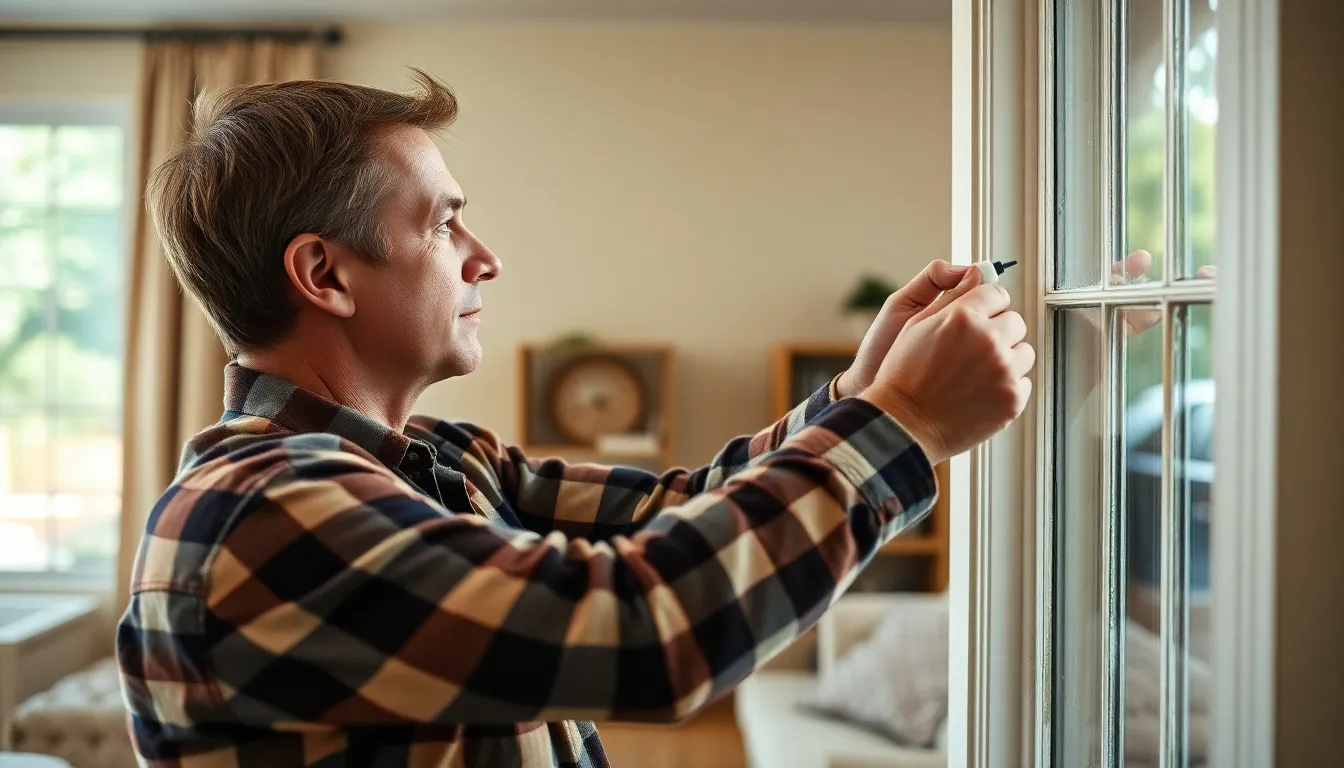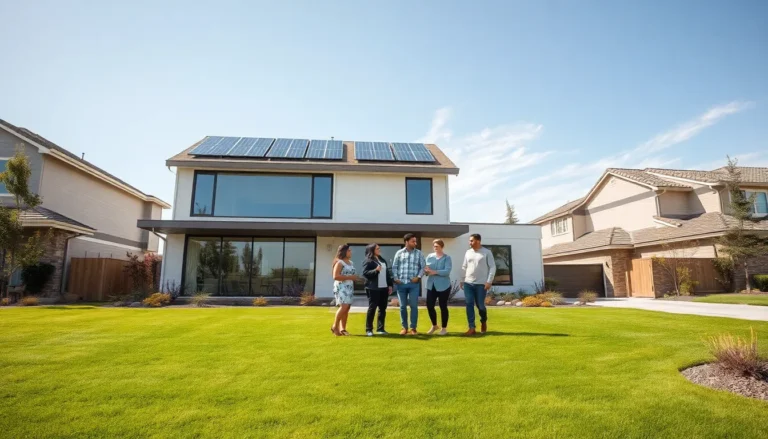Table of Contents
ToggleIn the battle against energy waste, air sealing strategies are the unsung heroes. Imagine your home as a cozy fortress, but pesky drafts are sneaking in like uninvited guests at a party. These sneaky air leaks can turn your heating and cooling bills into a horror story. Fortunately, sealing those gaps not only keeps the comfort in but also saves some serious cash.
With a few clever strategies, anyone can become a champion of air sealing. From caulking to weatherstripping, these solutions are as easy as pie—if pie were made of insulation and energy efficiency. So, let’s dive into the world of air sealing, where every little effort makes a big difference, and your home can finally stop playing hide-and-seek with your hard-earned money.
Overview of Air Sealing Strategies
Air sealing strategies focus on minimizing energy waste in homes. To begin, identifying common sources of air leaks—is essential for effective sealing. Common areas include windows, doors, and attics. These locations often harbor gaps that allow conditioned air to escape, increasing energy costs.
Caulking plays a critical role in sealing gaps around windows and doors. It offers a flexible, durable solution that prevents drafts. An application of caulk can significantly improve overall comfort. For larger gaps, foam sealants provide a more robust solution. This type of material expands to fill voids, ensuring a tight seal.
Weatherstripping is another effective method for air sealing. This strategy applies to movable components like doors and windows. Various types of weatherstripping exist, including adhesive-backed foam and V-shaped strips. Each type accommodates different needs, allowing for tailored solutions.
Blower door tests reveal the efficiency of air sealing efforts. These tests measure air leakage to pinpoint areas needing improvement. A powerful fan creates negative pressure, highlighting leaks. Homeowners can then prioritize repairs based on the results.
In addition, insulation complements air sealing techniques. Proper insulation reduces thermal bridging, enhancing energy efficiency. When combined with air sealing methods, homeowners achieve significant energy cost savings.
Implementing these strategies provides numerous benefits. Enhanced comfort and reduced energy costs create a more efficient living environment. These solutions represent simple, effective steps homeowners can take toward improved energy efficiency.
Benefits of Air Sealing
Air sealing offers crucial advantages for homes. It directly impacts energy efficiency and overall comfort.
Energy Efficiency
Improved energy efficiency results from reducing air leaks. Homes with effective air sealing consume 10-20% less energy according to the U.S. Department of Energy. By preventing conditioned air from escaping, homeowners experience lower heating and cooling costs. Sealed homes maintain consistent temperatures, allowing HVAC systems to operate more effectively. Sealing gaps around doors, windows, and attics enhances the performance of insulation. This combination maximizes energy savings and minimizes energy waste.
Improved Indoor Air Quality
Indoor air quality improves significantly with air sealing strategies. By blocking unwanted airflow, homes reduce the entry of allergens, dust, and pollutants. Controlling ventilation allows for better regulation of indoor environments. Proper air sealing decreases the infiltration of outside air that may carry irritants. Enhanced air quality results in healthier living conditions, benefiting occupants’ overall well-being. This creates a more comfortable atmosphere, especially for individuals with respiratory conditions.
Types of Air Sealing Strategies
Various air sealing strategies enhance home efficiency and comfort. Understanding each method allows homeowners to effectively reduce energy waste.
Weatherstripping
Weatherstripping serves as a flexible solution for movable components. It can be applied to doors and windows to prevent drafts. Many types exist, such as adhesive-backed foam, v-strips, and tubular rubber. Each type meets specific needs depending on the environment. Proper installation ensures optimal performance, leading to significant energy savings and improved indoor temperature control.
Caulking
Caulking fills smaller gaps and cracks that allow air leaks. It’s ideal for locations like trim, baseboards, and window frames. Available in various materials, such as silicone, acrylic, and polyurethane, each has unique properties and application methods. Effective caulking provides a long-lasting seal, preventing conditioned air from escaping and enhancing energy efficiency. Routine checks and touch-ups maintain the integrity of the seal.
Foam Sealants
Foam sealants tackle larger voids where air leakage occurs. Expanding foam fills gaps around plumbing, electrical outlets, and foundation cracks. It offers superior insulation while blocking air movement effectively. Applying foam sealants can lead to improved energy performance due to their high R-value. Homeowners must follow instructions to ensure proper expansion and adhesion for the best results.
Blown-In Insulation
Blown-in insulation covers large areas, enhancing thermal performance. It fits into walls and attics, offering an effective barrier against air leaks. Installing this insulation improves home energy efficiency, often resulting in a 10-20% reduction in energy costs. Choosing the right material, such as cellulose or fiberglass, affects long-term performance. Proper installation ensures a consistent thickness, maximizing the benefits of improved insulation.
Best Practices for Effective Air Sealing
Effective air sealing starts with recognizing areas in a home where air leaks may occur. Targeting these problem spots greatly improves energy efficiency and comfort.
Identifying Common Leak Areas
Common leak areas often include windows, doors, and attics. Gaps around frames and hinges allow conditioned air to escape easily. Inspecting these locations for drafts is crucial. Picking up on other potential leak sources like electrical outlets, plumbing penetrations, and basement walls also helps. Seasonal changes may amplify these leaks, prompting regular checks throughout the year. Homeowners often find that small gaps can lead to significant energy loss, making thorough inspections highly beneficial.
Tools and Materials Needed
Essential tools for air sealing projects include caulk guns and putty knives. Caulk, weatherstripping, and foam sealants represent common materials for filling gaps. Blower door tests may also assist in identifying leaks, enabling more targeted sealing efforts. Measuring tapes play a vital role in ensuring accurate lengths of weatherstripping. In addition, safety goggles and gloves ensure protection during the sealing process. With the right tools and materials, homeowners can effectively tackle air leaks, enhancing their home’s energy efficiency.
Conclusion
Implementing effective air sealing strategies is essential for any homeowner looking to enhance comfort and reduce energy costs. By addressing common leak areas and utilizing simple solutions like caulking and weatherstripping, significant improvements can be achieved. Regular inspections and maintenance ensure that these strategies remain effective over time.
The benefits of air sealing extend beyond energy savings. Improved indoor air quality and consistent temperatures contribute to a healthier living environment. Taking proactive steps toward air sealing not only fortifies a home against drafts but also leads to long-term financial savings and increased efficiency. Embracing these strategies is a smart investment in any home’s future.








